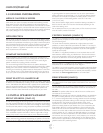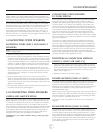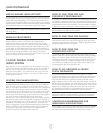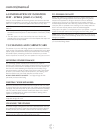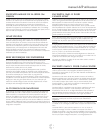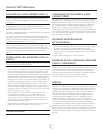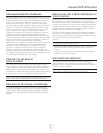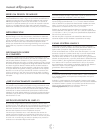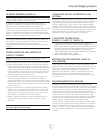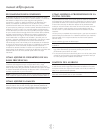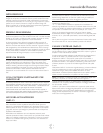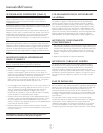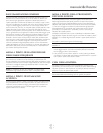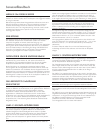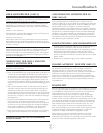
owners manual
2
1.0 GENERAL INFORMATION
MIRAGE OM DESIGN SERIES
Please take the time to read all of the instructions contained in this manual to
make certain your system is properly connected and functioning correctly.
Please retain the carton and packing materials for this Mirage product to
protect it in the event it ever has to be shipped to a service center for repairs.
Product received damaged by a service center that has been shipped by an end
user in anything other than the original packaging will be repaired, refurbished,
and properly packaged for return shipment at the end user’s expense.
INTRODUCTION
We are proud to welcome you as a new owner of a Mirage speaker system.
The finest components and materials are manufactured to exacting standards
and tested with sophisticated manufacturing and quality control techniques to
ensure exceptional performance that is superior to speakers costing several
times their price.This approach to the development of the Mirage OM
Design has resulted in a significant improvement over other system designs in
terms of performance and aesthetics.
COMPANY BACKGROUND
Mirage loudspeakers and subwoofers are designed and manufactured by
Audio Products International Corp., known throughout the industry as “API”.
A Canadian company founded in 1973,API is one of the world’s largest
speaker manufacturers, supplying products worldwide.
The renowned Mirage research team advances its speaker development
through the use of computer-based design techniques combined with multiple
listening rooms and anechoic chambers. A dedicated team of engineering,
marketing, and manufacturing people creates the finest speakers in the world
for your ultimate music or home theater listening pleasure. Now it’s time to
set up your system and experience the miracle of Mirage Omnipolar sound.
WHAT EXACTLY IS OMNIPOLAR?
Omnipolar technology uses natural room reflections to create a greater sense
of realism.This is accomplished by recreating the same ratio of direct to reflected
sound - 70% reflected and 30% direct, that is typically found in performance
spaces.A conventional speaker only produces 30% reflected sound. It is the
additional reflected sound provided by a Mirage Omnipolar speaker that
creates a miraculous three-dimensional sound experience in your home.
2.0 INITIAL SPEAKER PLACEMENT
FRONT SPEAKERS (OMD-15)
For best stereo imaging, the left and right speakers should be the same distance
from their respective sidewalls. If the distance from one speaker to the listener
is very different from the other it can affect the soundstage or stereo imaging.
Therefore, the ideal position is having the speakers equidistant to the listener.
When choosing the position for your new speakers, try to avoid walls with
predominately glass surfaces, as they might not be the best choice for placement.
If it is unavoidable to position the OMD-15 close to a glass wall or a large
window, it may result in a hard sound with too much reflected information.
NOTE: Do not install the feet to the OMD-15 until you have completed the
break-in and fine-tuning procedures. Repositioning the speakers with the feet
installed can be very difficult and could potentially cause damage to your floors.
A general guideline for speaker placement is to set up the space between
speaker and listener at approximately 1.2 to 1.5 times the distance between
the speakers. For example, if the speakers are ideally placed a minimum of
6-feet (1.8m) apart, the best seating position would be 7.2 to 9-feet
(2.16 to 2.4m) away.
Start with the speakers slightly toed in towards the listening area, ideally 2-4
feet from the rear wall and 3-4 feet from the sidewalls, depending on the
width of the listening room.
Do not attempt to fine-tune your audio system yet.This should only be done
once the break-in procedure is finalized.
CENTER CHANNEL (OMD-C1)
The OMD-C1's Omnipolar technology is uniform in dispersion, providing a
perfectly spherical, full spectrum sound radiation pattern that greatly expands
the prime listening area.
The center channel should be positioned at or slightly below ear level. If
possible, try to leave a little bit of space behind the OMD-C1.This will aid in
producing an open soundstage. It is not recommended to place the OMD-C1
on top of a large rear-projection style television set, as this could negatively
impact the sound quality.
The OMD-C1 is magnetically shielded, and it can be placed close to a CRT
based television without causing any interference. In the case where there is
some minor discoloration, simply move the speaker forward or backwards or
away from the television a few inches, this generally resolves the issue.
NOTE: LCD, DLP and Plasma displays do not suffer from magnetic interference.
When the OMD-C1 is installed on top of a television, in a cabinet or on a
shelf, please use the included table top mount. Diagram 1.
The OMD-C1 can be wall mounted by using the included wall bracket. Please
refer to the “mounting your speakers” section for detailed mounting instructions.
Alternatively Mirage's flexible Macromount bracket (sold separately) could be
used. Please visit www.miragespeakers.com for more information.
REAR SPEAKER (OMD-5)
NOTE:The versatile OMD-5 can also be used as a front speaker.The section
about placement for front speaker applies to the OMD-5 when used in such
an application.
The rear speakers can vary greatly in position depending on the room layout,
and the furniture placement.The ideal position is either on the sidewalls, or
rear walls.
Side Wall: This position utilizes the rear walls of the room to reflect sound
and create the "surround" effect.
Rear Wall:This is generally used when the sidewall position is not available to
you, due to furniture placement or room dimensions. It is also used in a 6.1
or 7.1 surround configuration. Both mounting positions have their advantages
and disadvantages, the position offering the best coverage of the entire room
should be chosen.The goal of the surround speakers during movie
reproduction is to create an "atmosphere" around you.The rear channel
speakers are ideally placed an equal distance from you as compared to the
front speakers. But this is not always possible in a home environment.The
OMD-5 will emit sound from both sides of the speaker, and is best placed
where it can use the walls to reflect the sound around the listeners.The best
mounting position for a 5.1 system is the Side Wall position, as it makes use
of the rooms' rear walls, and sidewalls. It will create a lifelike surround effect
and make the room sound larger than it is. In this position, try to mount the
speaker so that it is beside you or slightly behind you.The height should be
above ear level, at approximately 2/3 of the height of the wall.These general
guidelines should aid in positioning choices.




